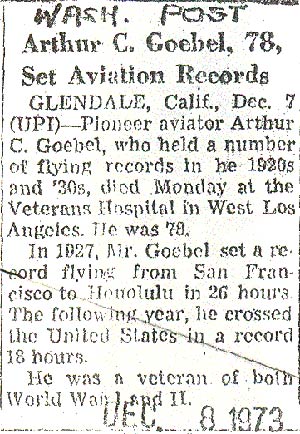|
"Say, folks, it's great to be here."
Arthur C. Goebel, ca. 1929
Image From His Book, Right
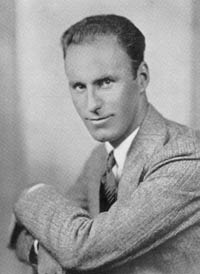 |
Arthur C. Goebel was born October 19, 1895 in Belen, NM. The 1900 U.S. Census, his first, placed him, age 4, with his family in Belen. His father was born in Germany and was a day laborer. His mother was born in Texas and was a dressmaker. According to the 1910 Census, the family had moved to East Rocky Ford, CO where his father was now a farmer. On June 5, 1917 he was registered for the WWI draft. He was 21 years old. I found no 1920 Census information.
Goebel served in World War I (not as a pilot). He learned
to fly in 1920 in California. Image, below left, shows him during
his student pilot days.
Learning to Fly in 1920
Image From His Book
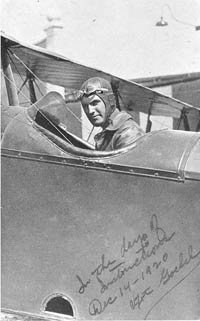 |
He landed at Tucson five times between 1928
and 1931. Among his many achievements, he holds the distinction
of being the only pilot to suggest obscenity in the Airfield
Register. On February 13, 1931 he wrote in the Remarks column
, "!?*!!?XX
weather"! We have to forgive him, though, because it
was February and he was traveling westbound from El Paso, TX to Los Angeles, CA, probably into the teeth of prevailing winter
westerly winds.
Art Goebel (L) Prepping for Movies. Image is From His
Book
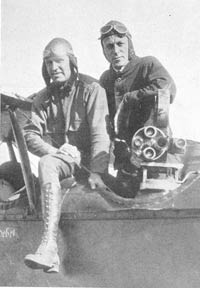 |
In the late 1920s, he belonged to
the "Thirteen
Black Cats of Hollywood," movie stunt fliers. Another member
of the Cats was Paul Richter.
His flying
skills and detailed preparation for movie scenes led to success
and notoriety as his flying career proceeded.
Image, right, of Goebel (left) with a cameraman
preparing for a movie shot.
The 1930 Census placed him at age 33 living with his parents at 1161 East 76th Place, Los Angeles, CA. Later in the 1930s he entered the U.S. Army Air Corps Reserves. During
WWII he served with distinction as a pilot and Air Inspector
of the IV Bomber Command in the Pacific Theater. He
rose to the rank of Colonel.
For his achievements in the late 1920s (see the Dole Race,
below) he accepted honors from the President of the United
States (Coolidge), standing shoulder to shoulder with the
likes of Charles Lindbergh (trans-Atlantic),
Bernt Balchen (North & South
Pole), William Brock & Edward Schlee (round-the-world)
and Lester Maitland & Albert
Hegenberger (trans-Pacific).
A year later, in August, 1928, Goebel flew the Lockheed Vega NX4789, the "Yankee Doodle" (not a Register airplane) from coast to coast in 18 hours and 58 minutes. This was the same airplane that, in November, Register pilot C.B.D. Collyer would meet his end.
Ann Jergens Sommermeier (Source: ancestry.com)
 |
In 1931 Goebel flew a Lockheed aircraft (Vega Model 5 NR7954,
the first “Winnie Mae”) in the first Bendix Trophy
race from Los Angeles to Cleveland, OH. He placed fifth
behind first-place winner James H. Doolittle. To see
an image of this airplane, please follow this link to the Klein
Archive of Aviation Photographs.
I found no Census information for 1940. In 1941
he married Ann Jergens Sommermeier, left, heir to the Jergens cosmetics empire.
Their marriage ended in divorce in 1947. He
never remarried. In the 1960s he was inducted as an honorary
member into The Society of Experimental Test Pilots.
For additional
images of A.C. Goebel, see this link
to his section of the C.B. Cosgrove Collection on this site .
---o0o---
One of Goebel's premier accomplishments, and a
real milestone for him during the late 1920's was his flight
across the Pacific Ocean from Oakland, CA to Honolulu in
a Travel Air transport named "Woolaroc." It wasn't the first time he traveled to Honolulu. An immigration form dated November 13, 1926 documented his travel to Wilmington, CA from Honolulu aboard the S.S. Calawaii. Below, Goebel loads
radio equipment in his airplane as part of the fastidious
preparations he made for the event.
Goebel Loads Radio Equipment, 1927
Image is
From His Book
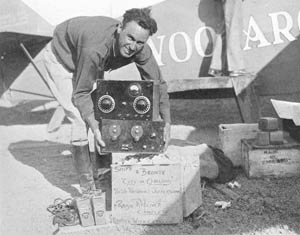 |
His
feat was as a competitor in the Dole Race (see slso the references
in the left and right sidebars) that was held in August 1927.
Although the Pacific had been crossed by airplane twice in
the months before, the Dole
Race was the first time prize money was offered.
Fellow civilians
Ernest L. Smith and Emory Bronte flew the same route in 25:36
on July 14-15. If you look carefully at the image, left, you'll
see Smith & Bronte's names written on the packing case below
the radio equipment. This equipment was carried during their
July 15th crossing, and loaned to Goebel for his August attempt.
Goebel's
navigator was Lieutenant William V. Davis Jr., an Annapolis
graduate and one of the most astute navigators of the era. It
took them 26 hours, 17 minutes and 33 seconds of flying time
to cover the 2,400 miles of ocean once they left Oakland
Airport. They took first place and won $25,000 for their
efforts. The compass from his airplane was removed and mounted at some point, and an engraved plate was placed on the wooden platform. It is pictured below in an undated photograph from the San Diego Aerospace Museum Flickr Stream (SDAM).
Woolaroc Compass, Date Unknown (Source: SDAM)
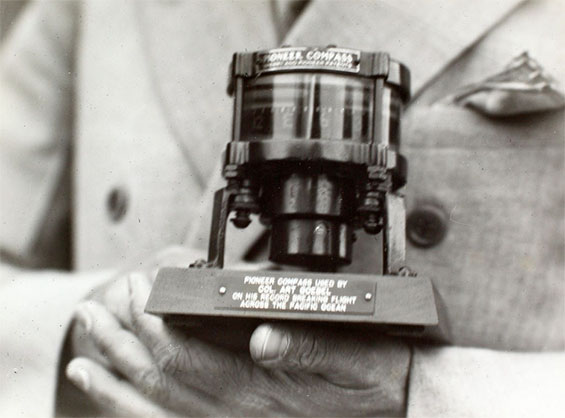 |
One of the flight's sponsors was the Phillips Petroleum Company. At the link, to the American Oil & Gas Historical Society Web site, is a description of the company's aviation activities, including the Dole Race and the "Woolaroc."
There is good Web presence for
the Dole Race. The images
linked above in the Cosgrove Collection show him with the "Woolaroc".
Below, from Goebel's book, the "Woolaroc" at Santa Monica
after its return to the U.S. by ship. From the crowds you can see that this race was a big deal at
the time! Note the "Fly With Bob" sign on the hangar,
top right. Hats were very popular.
"Woolaroc" at Santa Monica, CA, 1929
Image
From Goebel's
Book (Right Sidebar)
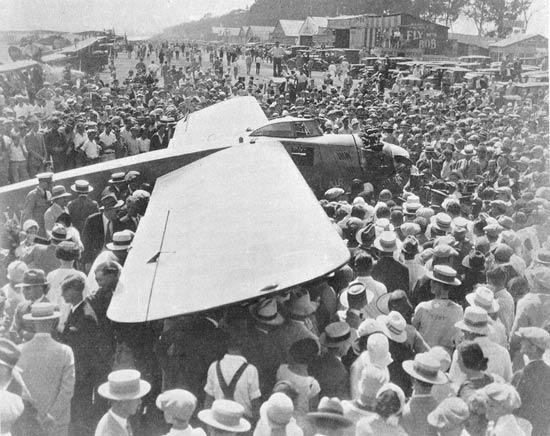 |
Time Magazine, Monday, Aug. 29, 1927, had this to say about
the Dole Race:
"'Say, folks, it's great to be here.' With these
words the flight for the $25,000 prize offered by James
D. Dole, "pineapple king," ended at Wheeler Field,
Honolulu. Arthur C. Goebel stepped out of his plane,
the Woolaroc, and waved to 30,003 assembled under the
clear blue Hawaiian sky. The small figure of a woman
raced up to him, exclaiming: 'God bless you, where
is Martin?' She was Mrs. Martin Jensen, wife of a pilot
in the flight. Two hours later Martin Jensen swung
his Aloha down from Hawaiian sky, jumped out, into
the arms of Mrs. Martin. He had won the second prize,
$10,000.
"Eighteen airplanes entered for the prize. Eight started.
Two crashed; two turned back; two disappeared; two
finished.
"Sifting qualifications, testing ships (three pilots
dying in the process), bickering a little, postponing
the starting time, those concerned in the Dole prize
flight to Hawaii finally set their stage.
"Bennet Griffin, flying the Oklahoma, rose from the
ground at Oakland, Calif., for the first takeoff, and
the race was on. At intervals behind him rose John
W. Frost flying the Golden Eagle; Capt. W. P. Erwin
flying the Dallas Spirit; J. Auggy Pedlar flying the
Miss Doran (carrying with him Miss Mildred Doran, school
teacher from Flint, Mich.); Goebel; and Jensen. Pabco
Flyer and El Encanto crashed at the start. Soon Erwin
returned with an unlucky windhole in his fuselage.
Soon Griffin returned, his engine failing. Out over
the blue Pacific flew Goebel, Jensen; Frost, Pedlar;
and their navigators; and Pedlar's passenger.
"The Woolaroc flew smoothly. In the night an oil brush
slipped under the floor boards, and began a pounding
vibration; a sound like pistons blowing. Goebel and
his pilot, W. C. Davis, seized the water bottle and
emergency rations and began peering below them for
a soft spot in the sea. The brush vibrated itself into
sight. They flew on. They saw land. They saw planes
coming to meet them. An army flyer circled close and
held up one finger. They knew they had won.
"The Aloha had trouble. Three times she went into
dangerous tail spins and three times pilot Jensen,
stunt flyer, pulled her out. Once, flying low because
only close to the sea would their compass work, they
bumped a wave; and rose above it. Once the gas pump
went wrong. Having no radio for bearings, three hours
were wasted shooting the sun. With gas left for a half
hour's flying they landed after 28 hours and 5 minutes;
nearly two hours behind Goebel. Of the Miss Doran and
the Golden Eagle no news. They were last sighted passing
the Farallon Islands, 30 miles off San Francisco. They
struck the water somewhere between the Farallons and
the Hawaiians, almost 2,400 miles beyond.
"Two score naval vessels and 20 merchant ships, navy
and army planes combed the Pacific. Flint, Mich., and
San Francisco proclaimed public prayer for the lost
flyers.
"Two days later arose from the Oakland Field Capt.
W. P. Erwin and navigator A. W. Eichwaldt in the Dallas
Spirit; the wind rent in her fuselage, which had ruined
her chances in the race, had been repaired. They were
flying for Hawaii, on a hunt for the Golden Eagle and
the Miss Doran. The ship was radio equipped. Messages
drifted back:
'Just passing Point Lobos (Golden Gate). Love to Ma.'
'Just saw a rum runner; had a time keeping Ike in.'
"'Tell the gentleman who furnished our lunch it was
fine, but we can't find the toothpicks.' 'We went into
a tail spin—SOS—delay that. We came out
of it but we were sure scared. The lights on the instrument
board went out and it was so dark that Bill couldn't
see the—we are in a spin —SOS . . .'
"At the time of the fatal spin the Dallas Spirit was
about 600 miles from San Francisco. Ships rushed to
rescue; found nothing.
"The Dole flight had killed three men (TIME, Aug.
22); one woman and six men were missing. Airmen criticized;
said preparations for the flight had been inefficient;
intimated that the fatalities could have been prevented.
Among the critics: Ernest L. Smith, first civilian
flyer to hop to Honolulu; Carl Wolfley, Vice President
of the National Aeronautic Association; Floyd Bennett,
Flyer Byrd's comrade on the North Pole flight; Charles
L. Lawrence, inventor of Wright Whirlwind airplane
engine." |
In addition to Time and all the flying
magazines, The New
York Times issues of
August 17-18 provide 13 full-length, front-page columns
of coverage for the Dole Race. This link [link was found to be inoperable 9/21/09] leads
you to a short British Pathe News motion picture film of
the beginning and end of the Dole Race. It shows a couple
of the failed takeoffs at Oakland and the arrival of the "Woolaroo" [sic]
at Honolulu.
Another hazard of the event was captured in an article from the Bakersfield Californian of August 16, 1927, below, courtesy of Mike Gerow. Ernie Smith had preceded Goebel across the Pacific by a few days.
Bakersfield Californian, August 16, 1927 (Source: Gerow)
 |
The loss of life during this one event caused
a major stir in the aviation community and among the public.
There was considerable finger-pointing at James Dole with
accusations of self-serving greed; at the pilots for not
being prepared; to the federal Bureau of Air Commerce for
not enforcing aircraft safety measures thoroughly enough.
The "blame" was
passed, with no one taking the responsibility. Some things
never change. This PDF
file (440KB) summarizes the circumstances around
the Dole Race as compiled from contemporary writings.
Autographed Calling Card, 1927 (Source: HAPS)
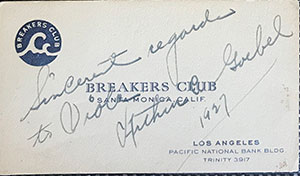 |
That
summary, and the reference in the left sidebar, are fairly
clear that there is no blame. This was a race with a good
deal of precedent, skill and technology applied to it. The
pilots and their passengers were all adults; nobody forced
them to participate in the event.
Caveat competitor.
A book written by your Webmaster about the Dole Race, which balances the roles of Goebel and Davis, is here: "Winners' Viewpoints: The Great 1927 Trans-Pacific Dole Race".
Post-Dole, Goebel was recognized and popular. At right is a calling card from the Breakers Club, Santa Monica, CA. It was autographed by Goebel to an unidentified "Viola." This card comes to us courtesy of a site visitor via the Hawaii Aviation Preservation Society (HAPS). The card was found inside a used copy of Charles Lindbergh's "We."
Below, courtesy of the SDAM is a photograph of Goebel among a group of at least 21 female pilots. The date, location and event are unidentified. The pose might commemorate Goebel's trans-Pacific flight, or perhaps a women's flying event.
Art Goebel and Female Aviators (Source: SDAM)
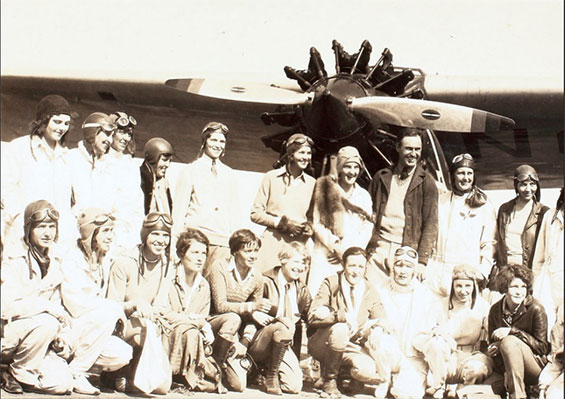 |
The woman in the fur appears to be Margaret Cooper Perry; in the back row, far right looks like May Haizlip. The one kneeling far right appears to be Aline Miller. Fourth from the right is Bobbie Trout. If you can identify any of the others, please let me KNOW. A site visitor identifies the woman in the back row, far left, as Aloha Wanderwell Baker, an intrepid adventurer who traveled around the world by automobile and airplane during the 1920s.
Apropos navigator Davis, the postal cachet, below, courtesy of site visitor Jeff Staines, was signed by Davis ca. 1933. It was not mailed; therefore not postmarked.
William V. Davis, Jr., Postal Card Cachet, Ca. 1933 (Source: Staines)
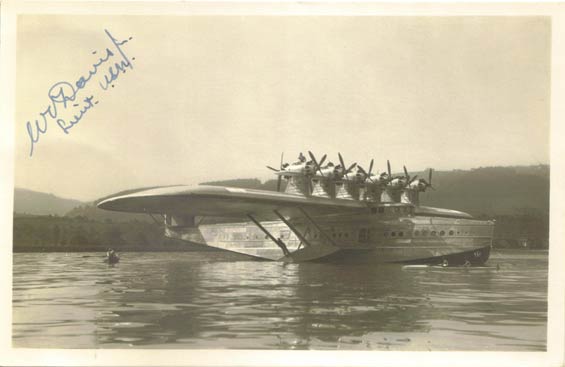 |
Mr. Staines says about his cachet, "This is a photo postcard of the famous Dornier DO-X aircraft dated 1933. It is signed by Lt. William V. Davis Jr. and is addressed to Arthur Flury in Switzerland. Among his other attributes, Flury compiled and published many transoceanic flight charts over the years. This may be the tie-in between Navigator Davis and Flury on this particular item. The card is stamped but was never postmarked. Maybe it was handed to Flury by Davis himself, or maybe it was sent to him along with other mail in a larger package. I also have never found the reason why Davis would autograph a Dornier photo. This postcard has been a mystery to me for a few years now." Does anyone KNOW the context of this exchange? Below, the address side of the postcard.
William V. Davis, Jr., Postal Card Cachet, Ca. 1933 (Source: Staines)
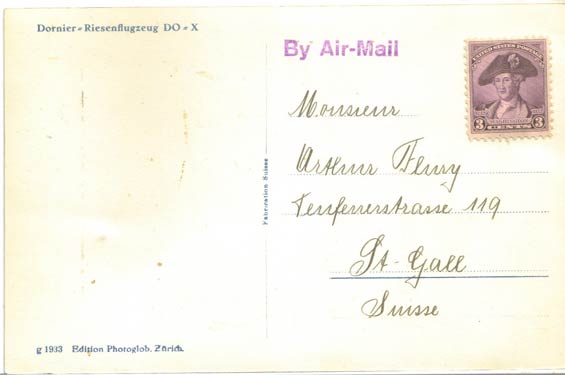 |
---o0o---
The only image I have of Goebel with one of the airplanes
he brought to Tucson is the one below of him taken May 9,
1932 with Waco ATO NX9580.
He flew this airplane to Tucson about three years earlier,
on October 29, 1929, when it was registered as "NC".
Art Goebel With Waco NX9580, 1932
 |
Although it is not identifiable by number, chances are high that the airplane in the photograph below, also taken at Randolph Field on May 9, 1932, is NX9580. The forward swoop of the fuselage paint scheme is an indicator. The photograph is from the University of North Texas Portal to Texas History (UNT) at the link.
Art Goebel (L) and Unidentified Gentleman, May 9, 1932, Randolph Field (Source: UNT via Woodling)
 |
---o0o---
Born October 19, 1895, Goebel flew West December 3, 1973 from Los Angeles. Art Goebel
led a full aviation life (obituary at right). He has a good Web
presence, with this link being
one of the nicer sketches with additional images and links.
This link [link was found to be inoperable 9/21/09 and removed] gets
you a moving picture clip of Goebel and the Lockheed Vega
"Yankee Doodle" (NX4769, not a Register airplane) at the end of one of his record flights. The "Yankee Doodle" was later destroyed in a crash during another record attempt. Goebel was not on board.
This link takes you to another photograph of Goebel taken May 9, 1932 at Randolph Field, TX. Compare it with the one above. From the paint pattern, the airplane in the background of both photos looks the same; Goebel took off his jacket in the photo above. Does anyone RECOGNIZE the gentleman on the right in the photo at the link?
---o0o---
Update of 09/04/10 Sorrowfully, I announce the passing on August 25, 2010 of our friend William V. Davis, III. His father was navigator/co-pilot with Register pilot Art Goebel during the Dole Race of August, 1927. I will miss Bill's friendship and kind attention, and his help to bring balance to the story of the Dole Race.
Goebel Called to WWII Duty, Flying Magazine, August, 1942
 |
Bill wrote the warm and informative Foreword for our book (see the left sidebar) "Winners' Viewpoints: The Great 1927 Trans-Pacific Dole Race." His father and Goebel were the victors in that event. In addition to his Foreword, Bill and his family shared many personal photographs and documents that are published in the book, and that appear elsewhere on this Web site.
---o0o---
This article, left, appeared in Flying magazine, August, 1942, less than a year into WWII. Goebel was again in the Army, assigned to the Army flying school at Midland, TX.
---o0o---
Dossier 2.1.93
THIS PAGE UPLOADED: 01/04/07 REVISED: 03/06/07, 07/19/07, 09/29/07,
10/08/07, 02/20/08, 01/22/09, 07/02/09, 09/21/09, 11/02/09, 04/06/11, 07/08/11, 01/21/14, 07/16/14, 12/01/14, 12/03/14, 12/26/16, 11/22/20
|
















